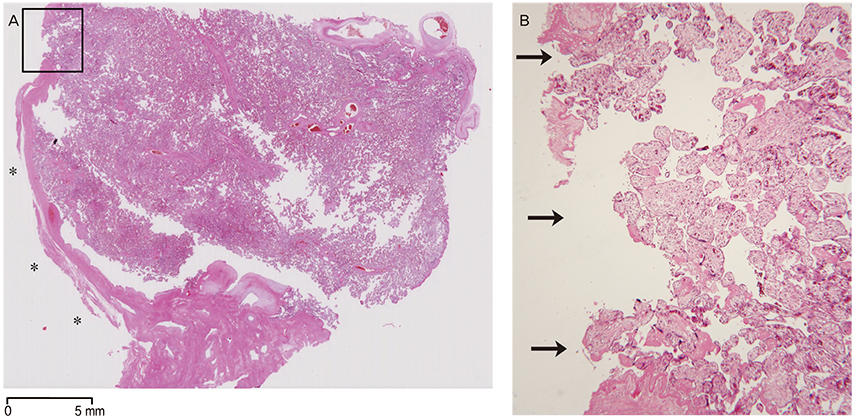Obstet Gynecol Sci.
2014 Sep;57(5):397-400. 10.5468/ogs.2014.57.5.397.
Placenta percreta with a vaginal fistula after successful management by uterine transverse fundal incision and subsequent cesarean hysterectomy
- Affiliations
-
- 1Department of Obstetrics and Gynecology, Osaka University Graduate School of Medicine, Osaka, Japan. zacky@gyne.med.osaka-u.ac.jp
- 2Department of Pathology, Osaka University Graduate School of Medicine, Osaka, Japan.
- KMID: 2051722
- DOI: http://doi.org/10.5468/ogs.2014.57.5.397
Abstract
- Placenta previa presents a highest risk to pregnancy, and placenta accreta is the most serious. Placenta accreta requires cesarean delivery and often results in massive obstetric hemorrhage and higher maternal morbidity. Challenges associated with cesarean delivery techniques may contribute to increased maternal blood loss and morbidity rates. Several recent obstetric studies reported the usefulness of transverse uterine fundal incision for managing placenta accreta. We present a case of placenta percreta that was treated by a transverse fundal incision. We successfully avoided cutting through the placenta and helped decrease maternal blood loss. After delivery, the patient underwent a cesarean hysterectomy. Postoperative day 48, she experienced watery discharge and was diagnosed with vaginal fistula. We present our case and review the literature.
MeSH Terms
Figure
Reference
-
1. Publications Committee, Society for Maternal-Fetal Medicine. Belfort MA. Placenta accreta. Am J Obstet Gynecol. 2010; 203:430–439.2. Matsubara S, Kuwata T, Usui R, Watanabe T, Izumi A, Ohkuchi A, et al. Important surgical measures and techniques at cesarean hysterectomy for placenta previa accreta. Acta Obstet Gynecol Scand. 2013; 92:372–377.3. Shukunami K, Hattori K, Nishijima K, Kotsuji F. Transverse fundal uterine incision in a patient with placenta increta. J Matern Fetal Neonatal Med. 2004; 16:355–356.4. Kotsuji F, Nishijima K, Kurokawa T, Yoshida Y, Sekiya T, Banzai M, et al. Transverse uterine fundal incision for placenta praevia with accreta, involving the entire anterior uterine wall: a case series. BJOG. 2013; 120:1144–1149.5. Nishida R, Yamada T, Akaishi R, Kojima T, Ishikawa S, Takeda M, et al. Usefulness of transverse fundal incision method of cesarean section for women with placentas widely covering the entire anterior uterine wall. J Obstet Gynaecol Res. 2013; 39:91–95.6. Clausen C, Lonn L, Langhoff-Roos J. Management of placenta percreta: a review of published cases. Acta Obstet Gynecol Scand. 2014; 93:138–143.
- Full Text Links
- Actions
-
Cited
- CITED
-
- Close
- Share
- Similar articles
-
- Spontaneous Uterine Rupture with Placenta Percreta
- A Case of Placenta Previa-Percreta Treated with Methotrexate Treatment
- A Case of Placenta Percreta Involving the Urinary Bladder
- A case of placenta previa percreta with bladder invasion
- Spontaneous uterine rupture due to placenta percreta in the second trimester of pregnancy: a case report



